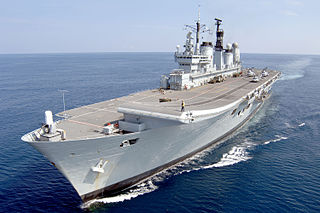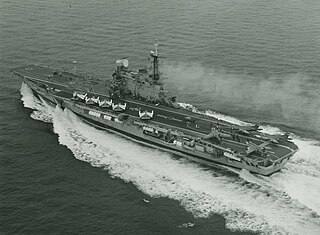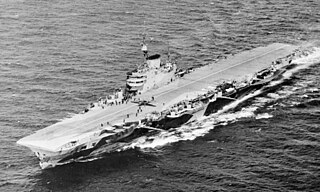This article needs additional citations for verification .(February 2024) |
The list of ship decommissionings in 1981 includes a chronological list of all ships decommissioned in 1981.
This article needs additional citations for verification .(February 2024) |
The list of ship decommissionings in 1981 includes a chronological list of all ships decommissioned in 1981.

INSVikrant was a Majestic-class aircraft carrier of the Indian Navy. The ship was laid down as HMS Hercules for the British Royal Navy during World War II, but was put on hold when the war ended. India purchased the incomplete carrier in 1957, and construction was completed in 1961. Vikrant was commissioned as the first aircraft carrier of the Indian Navy and played a key role in enforcing the naval blockade of East Pakistan during the Indo-Pakistani War of 1971.

The Invincible class was a class of light aircraft carrier operated by the Royal Navy. Three ships were constructed: HMS Invincible, HMS Illustrious and HMS Ark Royal. The vessels were built as aviation-capable anti-submarine warfare (ASW) platforms to counter the Cold War North Atlantic Soviet submarine threat, and initially embarked Sea Harrier aircraft and Sea King HAS.1 anti-submarine helicopters. With cancellation of the aircraft carriers renewal programme in the 1960s, the three ships became the replacements for Ark Royal and Eagle fleet carriers and the Centaur-class light fleet carriers, and the Royal Navy's sole class of aircraft carrier.

HMS Ark Royal was a light aircraft carrier and former flagship of the Royal Navy. She was the third and final vessel of the Invincible class. She was built by Swan Hunter on the River Tyne and launched by them in 1981. Ark Royal was christened by Queen Elizabeth The Queen Mother. She followed sister ships HMS Invincible and HMS Illustrious into service in 1985.

HMS Hermes was a conventional British aircraft carrier and the last of the Centaur class.

HMS Invincible was the Royal Navy's lead ship of her class of three light aircraft carriers. She was launched on 3 May 1977 as the seventh ship to carry the name. She was originally designated as an anti-submarine warfare carrier, but was used as an aircraft carrier during the Falklands War, when she was deployed with HMS Hermes. She took over as flagship of the British fleet when Hermes was sold to India. Invincible was also deployed in the Yugoslav Wars and the Iraq War. In 2005, she was decommissioned, and was eventually sold for scrap in February 2011.

Arromanches (R95) was an aircraft carrier of the French Navy, which served from 1946 to 1974. She was previously HMS Colossus (15) of the Royal Navy. She was the name-ship of the Colossus class of light carriers. She was commissioned in 1944, but did not see any action in World War II. She served with the British Pacific Fleet in 1945–46, as an aircraft transport and repatriation ship.

The Implacable-class aircraft carrier consisted of two aircraft carriers built for the Royal Navy during World War II. Derived from the design of the Illustrious class, they were faster and carried more aircraft than the older ships. They were initially assigned to the Home Fleet when completed in 1944 and attacked targets in Norway as well as the German battleship Tirpitz. Subsequently, they were assigned to the British Pacific Fleet (BPF).

HMS Ark Royal (R09) was an Audacious-class aircraft carrier of the Royal Navy and, when she was decommissioned in 1979, was the Royal Navy's last remaining conventional catapult and arrested-landing aircraft carrier. She was the first aircraft carrier to be equipped with angled flight deck at its commissioning; her sister ship, HMS Eagle, was the Royal Navy's first angle-decked aircraft carrier after modification in 1954. Ark Royal was the only non-United States vessel to operate the McDonnell Douglas Phantom at sea.

The Centaur class aircraft carrier was the final iteration of the 1942 Design Light Fleet Carrier developed by the United Kingdom for the Royal Navy during the Second World War. They were designed in 1943 to operate higher-performance aircraft than the preceding Majestic-class aircraft carrier. Four ships were laid down in 1944-1945 and completed in 1953-1959. Rapid developments in carrier warfare and technology overtook the ships even as they were under construction, and the associated costs of modernization led to ships being completed to different specifications. Only the last ship, HMS Hermes (R12), was fitted as a modern fixed-wing carrier; she was also the last of the class to retire in 2017 as INS Viraat.

The sixth HMS Bulwark of the Royal Navy was a 22,000 ton Centaur-class light fleet aircraft carrier. Initially commissioned as a light aircraft carrier in 1954, the ship was converted into a commando carrier in 1958 and recommissioned as such in 1960. Bulwark remained in this capacity until 1979 following failed efforts to sell the ship, Bulwark re-entered service as an anti-submarine warfare carrier and remained as such until being decommissioned in 1981. The ship was scrapped in 1984.

The 1942 Design Light Fleet Carrier, commonly referred to as the British Light Fleet Carrier, was a light aircraft carrier design created by the Royal Navy during the Second World War, and used by eight naval forces between 1944 and 2001. They were designed and constructed by civilian shipyards to serve as an intermediate step between the expensive, full-size fleet aircraft carriers and the less expensive but limited-capability escort carriers.

HMS Unicorn was an aircraft repair ship and light aircraft carrier built for the Royal Navy in the late 1930s. She was completed during World War II and provided air cover over the amphibious landing at Salerno, Italy, in September 1943. The ship was transferred to the Eastern Fleet in the Indian Ocean at the end of the year. Unicorn supported the aircraft carriers of the fleet on their operations until the British Pacific Fleet (BPF) was formed in November 1944. She was transferred to Australia in early 1945 to support the BPF's operations during Operation Iceberg, the Allied invasion of Okinawa in May. To shorten the time required to replenish the BPF's carriers, the ship was based in the Admiralty Islands and in the Philippine Islands until the Japanese surrender in August. Unicorn was decommissioned and placed in reserve when she returned to the UK in January 1946.

The Royal Navy built three aircraft maintenance carriers for its Fleet Air Arm before and during World War II. The Abyssinia Crisis of 1934–35 demonstrated to the Admiralty that it needed a depot ship to support the aircraft carriers in active service, just like submarine and destroyer tenders supported those types. Begun just before the start of World War II in 1939, HMS Unicorn was the first ship built in any navy that could "carry out the full range of aircraft maintenance and repair work in addition to the ability to operate aircraft from the flight deck". Unicorn proved the value of the concept and two similar support ships, Perseus and Pioneer were converted into aircraft maintenance ships by modifying light carriers while still under construction. Unlike Unicorn, neither Pioneer nor Perseus were able to land aircraft; they had to be craned aboard.

SS Hobbs Victory was a cargo Victory ship built for World War II under the Emergency Shipbuilding program. Hobbs Victory, was launched on January 9, 1945 by Permanente Metals Corporation, Richmond, California and completed on January 9, 1945. She was built in just 87 days. She was operated by the Sudden & Christenson for the United States Maritime Commission.